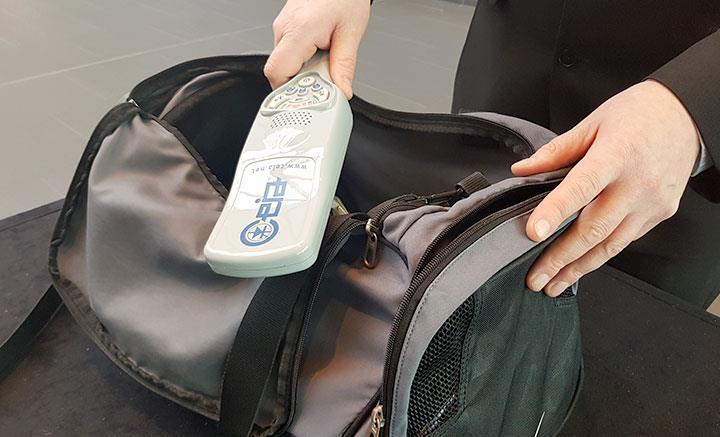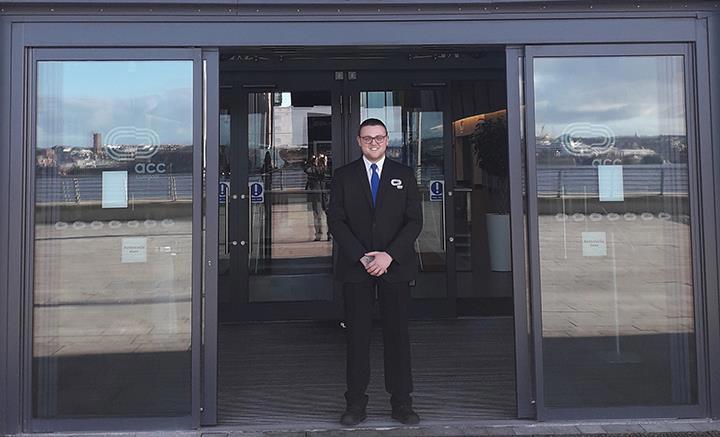What is Martyn's Law? A Guide to Event Security
The draft Terrorism (Protection of Premises) Bill, aka Martyn’s Law, will have a big impact on how venues prepare and respond to event security. Keep reading to learn more from the ACC Liverpool team…



Event security is essential. As a venue and/or event planner, we are being trusted with the safety and wellbeing of our guests, which means we need to ensure we’re doing everything we can to detect threats and protect our guests.
In this article, we’re going to explore the potential impact of a new act that has recently received Royal Assent, and is due to be implemented over the next 24 months – colloquially called Martyn’s Law. We’ll explain what this act is, and how Martyn’s Law will affect event security within the events industry.
What is Martyn’s Law?
The name Martyn’s Law comes as recognition of the tireless campaigning of Figen Murray, who has worked incredibly hard to get the Act presented to Parliament. Her son, Martyn Hett (for whom the law is named), was one of the 22 people killed in the Manchester Arena attack in 2017 following an Ariana Grande concert.
The official name of this law is the Terrorism (Protection of Premises) Act 2025. It is aimed at improving venue preparation and response to potential terror attacks, in order to mitigate the effects of a terror attack on the general public.
As of Thursday 3rd April, Martyn’s Law received Royal Assent, and the Government intends for there to be an implementation period of approximately 24 months. This timeframe is designed to allow businesses and event venues time to fully understand their new obligations, and enact any protocols that will now be legally required to ensure the safety of their attendees and the general public.
Note – Martyn’s Law will be applicable across England, Wales, Scotland and Northern Ireland.
Why is Martyn’s Law important?
Preventative preparation, and effective responses to large-scale security risks like terror attacks is a vital part of any event security plan. From venues to event planners, understanding which measures we can put in place to protect staff and attendees at our events is a key part of the role.
Martyn’s Law is important because, for the first time, it sets out clear and concise guidelines for venues to follow in order to “improve protective security and organisation preparedness”. The Act is designed to help venues ensure that we’re meeting all the requirements we can to make our events safer for the general public. Laying out a clear framework gives venues something to work to, helping to avoid forgotten areas and standardising certain aspects of event security.
This is also important because creating preparedness plans and test situations can help to make our staff more confident in their response during an actual emergency. Learned behaviour increases self-assurance and confidence, which will help if they ever experience the situation for real.
What venues does Martyn’s Law apply to?
There are several requirements for a venue to fall under the jurisdiction of Martyn’s Law, including:
- Premises and events must be accessible to the public for the purpose of the event.
- Premises’ purpose must be one of those specified in the Act. These can include retail areas, events venues, entertainment and leisure venues, etc.
- The premises must not be excluded under Schedule 2 of the act, such as premises with existing protective frameworks or open-access areas without ticket restrictions.
- Premises must have capacity for at least 100 people.
- Premises may be a building or location with clearly defined boundaries and access routes (by permission).
- Temporary events like festivals are also included in the Act, where guests need permission to enter, and a capacity of more than 800 people.
Note – at ACC Liverpool, our Venue would fall under the enhanced tier of Martyn’s Law (see below).
How does Martyn’s Law work?
With the phased implementation of Martyn’s Law, event venues will have the responsibility to complete “necessary but proportionate” steps – dictated by their capacity – to “mitigate the impact of a terror attack”. The Act also aims to reduce the potential harm of a terror attack by improving the response of a venue during the critical beginning stages after an incident.
However, not all venues will fall under the same criteria. Public areas will be divided by their capacity into separate tiers, which will then dictate the measures they need to complete. The type of event may also affect how Martyn’s Law will be implemented, as requirements can change to meet the needs of the situation.
Note - the person responsible for enacting these safety measures will be “the person who has control of the premises at which the event will be held for the purposes of the event”. An example of this is a concert. At a public park, the responsibility to enact measures from Martyn’s Law will be on the organising company; meanwhile, if the same event was held at a stately home, the responsibility would fall onto the controllers of said estate.
Below, we’ve explained the key elements of each tier, and how they will apply to a venue.
Standard tier
Under Martyn’s Law, the standard tier is a baseline measure for venues with a capacity between 100 and 799. The Act aims to set out low-cost, practical, and effective measures to help improve preparedness in cases of an attack.
This may include sharing information, providing additional training for staff, and creating a preparedness plan to ingrain certain practices. Examples include locking doors to prevent easy progress through a venue, or providing enhanced first aid training to staff members so they can provide vital care before the emergency services arrive.
The aim of the phased timeframe, where the Act will come into practice over 24 months, is to allow venues and businesses time to prepare and plan. As the Act requires responsible parties to provide a proportionate response, this time allowance ensures that it is possible for smaller venues to achieve the necessary steps, without being a burden. This balance is essential, as the law is designed to protect people, not penalise businesses because they don’t have the infrastructure or budget to meet the new requirements.
Enhanced tier
Larger events and venues, with 800+ capacity, will fall under the enhanced tier of Martyn’s Law. The enhanced tier has additional requirements to fulfil, largely in recognition that there is the possibility for more serious ramifications of a successful attack at a larger venue; such as the number and severity of injuries, and the difficulty of a response on a large scale.
Measures under the enhanced tier include; taking “reasonably practicable” actions to reduce the risk of a terrorist attack and reduce the physical harm caused, keeping and updating an assessed security document, and designating a “senior member” of staff for the venue or event.
Top tip – for more information about Martyn’s Law, explore the resources available from ProtectUK and the Home Office Factsheet.
What does Martyn’s Law mean for the events industry?
Martyn’s Law is a welcome addition to the legal discourse around event safety, and will have a clear impact on how we approach events in the future.
In this section, we’ve picked out several of the key takeaways of Martyn’s Law for the events industry, and offered some tips to prepare for the future.
Invest in more training
Unfortunately, a law will not stop terror attacks entirely. But, we can control how we prepare and respond to these situations.That’s why a huge part of Martyn’s Law is focussed on preparation, risk-reduction, and response.
What this means for event venues is that security training will become legally required. Venues, and event organising companies, should take this Act as encouragement to invest time and energy into creating preparedness plans, offering first aid training, and more in-depth security training for all staff. All levels of the organisation should be involved at some stage of the process to ensure people have the confidence and support to react appropriately in dangerous situations.
Additionally, by offering more training and support, we can build trust between our venue and future attendees. By showing we’re putting in the work to improve security, people may be encouraged to attend, knowing their safety is being prioritised.
Top tip – repeat training often to ensure people remember what to do, and are regularly updated if anything changes.
Improve your security culture
Martyn’s Law is designed to help us improve our overall security culture as event venues and organisers. However, whilst it’s still going through the implementation process, there are plenty of actions we can (and should) take to prepare for terror attacks and events with elevated security risks. These include:
Risk assessments
Whilst they may seem daunting, risk assessments are an essential part of preparing for event security. These documents allow us to predict, prepare for, and counteract risks present at our venues, or due to a specific event.
By reviewing these regularly, we can make sure our risk assessments are up-to-date, as well as ensure everyone knows about the relevant areas. We recommend reviewing risk assessments at least once a year, and consider having monthly conversations to discuss new scenarios and solutions to prepare for future situations.
Top tip – don’t let your risk assessment sit on a shelf. Regularly review and practise what is written to ensure staff know what to do in an emergency.
Create security plans
Security plans are an integral part of Martyn’s Law. These can then be tweaked and perfected as they need to be with support from the Government and other official partners in the future.
Security plans should be scalable to match the UK threat level but they also need to be proportionate to the operation. Security deployment should be seen as a welcome necessity and not an obstruction to an enjoyable event.
Top tip – like risk assessments, make sure you're proactive about testing security plans with your staff members.
Build relationships with other businesses
If there’s one thing we can learn with Martyn’s Law, it’s that event security is a collective responsibility. Every venue and event organiser brings important viewpoints to the table – so why wouldn’t we work collaboratively when it comes to guest safety?
By building relationships with your neighbours, you can gain an understanding of different security practices, and share knowledge and expertise on difficult problems. These relationships will also be valuable in the event of a terror attack, as everyone can work together to mitigate the effects of the attack and use a collective response to great effect.
Top tip – understanding the security response of those around you can help you direct people in an emergency.
Connect with ProtectUK
There are dozens of valuable resources to help us enact and prepare for full implementation of Martyn’s Law, including ProtectUK. This is an information-sharing platform for counter-terrorism and security and was set up to create a community focused on improving security in the UK.
With free online courses in security and counter-terrorism, updated news, and plenty of guidance for businesses and members of the public, ProtectUK is a valuable resource to help us improve our preparation and response to terror attacks as a venue.
Top tip – alongside ProtectUK, the ACT awareness courses are an exceptionally valuable resource for effective event security training.
Encourage asking questions
Improving security culture means fostering an environment where people (staff especially) are unafraid to ask questions. By investing in staff, and encouraging them to raise points or ask questions, we’re building their confidence and ensuring they know about the security plans of your venue – which is vital during a security incident like a terror attack.
Top tip – get staff comfortable with your security measures, and listen to their concerns or suggestions.
Security support
As you have seen, Martyn’s Law has been passed into law to support and improve event security through a series of legal guidelines. One of the key positives of putting these mandates into law is that there will be more support and guidance to help businesses and venues comply.
As we mentioned above, the standard tier of Martyn’s Law has been evaluated to ensure the regulations are fair, proportionate, and possible for smaller businesses. Instead of an additional burden, Martyn’s Law will hopefully be a useful benchmark for businesses to understand and implement valuable changes in their security plans to help everyone stay safe.
Note – as a legal mandate, there will be consequences for failing to comply with the law. These will likely be fines of a set fee or percentage of revenue, whichever would be higher.
Trust ACC Liverpool with your next event
At ACC Liverpool, security is of the utmost importance. We regularly review our Safety and Security measures and work with Merseyside Police to make sure our delegates are as safe as possible. For more information about hosting an event at ACC Liverpool, Contact our Team today.
How to Run Carbon Neutral Events | The Conference Organisers’ Guide to Jargon | The Essential Guide to Event & Conference Personalisation
